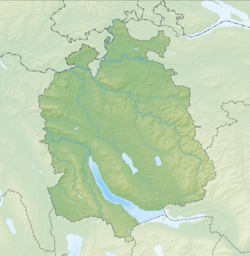Oberweningen facts for kids
Quick facts for kids
Oberweningen
|
||
|---|---|---|
 |
||
|
||
| Country | Switzerland | |
| Canton | Zurich | |
| District | Dielsdorf | |
| Area | ||
| • Total | 4.94 km2 (1.91 sq mi) | |
| Elevation | 465 m (1,526 ft) | |
| Population
(Dec 2020 )
|
||
| • Total | 1,897 | |
| • Density | 384.0/km2 (994.6/sq mi) | |
| Postal code |
8165
|
|
| Surrounded by | Bachs, Fisibach (AG), Regensberg, Schleinikon, Schöfflisdorf, Siglistorf (AG) | |
Oberweningen is a small town, also known as a municipality, located in Switzerland. It is part of the Dielsdorf district in the canton of Zürich. It's a quiet place with a mix of farms and homes.
Contents
A Look Back in Time
Oberweningen has a long history! It was first mentioned in old records between the years 1096 and 1111. Back then, it was called Waningen. Later, in 1291, its name changed to Oberenweningen, which is very similar to what it's called today.
Exploring Oberweningen's Geography
Oberweningen covers an area of about 4.9 square kilometers (about 1.9 square miles). A large part of this land is covered by forests, making up about 55.9% of the area. Another 35% of the land is used for farming.
Land Use in Oberweningen
About 8.6% of Oberweningen's land is developed with buildings and roads. A tiny part, 0.4%, is made up of non-productive areas like rivers. The town itself has scattered farmhouses and single-family homes. These are nestled between the Lägern ridge and a forest called Eggwald, all within the Wehntal valley.
People and Population
As of the latest count, Oberweningen has a population of 1,897 people. In 2007, about 15.1% of the people living here were from other countries. Over the past ten years, the number of people living in Oberweningen has grown by about 16.6%.
Languages Spoken in Oberweningen
Most people in Oberweningen speak German, making up about 92.1% of the population in 2000. Italian is the second most common language, spoken by 1.7% of residents. Albanian is the third most common, spoken by 1.2% of the people.
Age Groups in the Community
In 2000, children and teenagers (ages 0–19) made up 28.9% of Oberweningen's population. Adults (ages 20–64) were the largest group, at 63.8%. Seniors (over 64 years old) made up 7.3% of the population.
Education and Work in Oberweningen
Many adults in Oberweningen have a good education. About 81.2% of people aged 25-64 have finished either advanced high school or higher education. This includes university or a specialized college called a Fachhochschule.
The unemployment rate in Oberweningen is quite low, at 2.35%. In 2005, many people worked in different areas:
- 41 people worked in the primary economic sector, which includes farming. There were 11 businesses in this area.
- 49 people worked in the secondary sector, which includes manufacturing. There were 11 businesses here.
- 115 people worked in the tertiary sector, which includes services like shops and offices. There were 30 businesses in this sector.
Historical Population Data
Here's how Oberweningen's population has changed over the years:
| year | population |
|---|---|
| 1634 | 116 |
| 1850 | 419 |
| 1900 | 297 |
| 1950 | 325 |
| 2000 | 1,290 |
Getting Around: Transport
Oberweningen has its own train station, called Schöfflisdorf-Oberweningen railway station. This station is part of the Zürich S-Bahn network, served by lines S5 and S55. You can reach Zürich Hauptbahnhof, a main train station, in about 29 minutes from Oberweningen.
Famous People from Oberweningen
- Inigo Gallo (1932–2000), was a well-known actor and playwright.
Images for kids
-
.
A chart showing how Oberweningen's population changed between 1850 and 2000.





